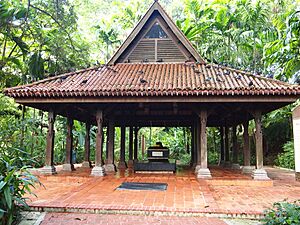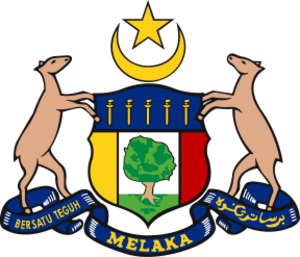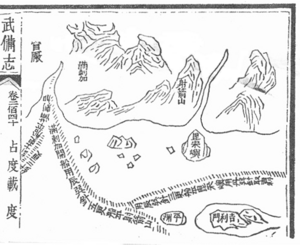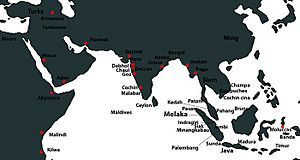Parameswara of Malacca facts for kids
Quick facts for kids Parameswara |
|
|---|---|
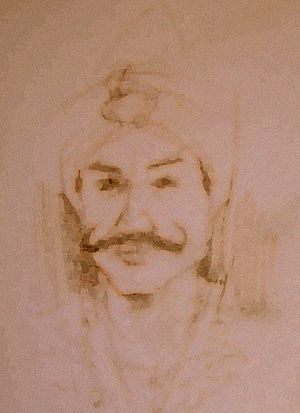
A depiction of Parameswara
|
|
| 1st Sultan of Malacca | |
| Reign | 1402–1414 |
| Predecessor | Sultanate founded |
| Successor | Megat Iskandar Shah |
| 5th Raja of Singapura | |
| Reign | 1389–1398 |
| Predecessor | Sri Maharaja |
| Successor | Kingdom disestablished |
| Born | 1344 Kingdom of Singapura or Palembang |
| Died | 1414 (aged 70) Melaka, Malacca Sultanate |
| Burial | Tanjung Tuan, Malacca or Bukit Larangan, Singapore |
| Spouse | Puteri Ratna |
| Issue | Megat Iskandar Shah |
| House | Malacca |
| Father | Sri Maharaja |
| Religion | Hinduism |
Parameswara (born 1344, died around 1414) was a very important historical figure. He was the last king of Singapura (modern-day Singapore). He also founded the powerful Malacca Sultanate. Many historians believe he is the same person called Iskandar Shah in the Malay Annals, a famous historical text.
According to the Malay Annals, Parameswara ruled Singapura from 1389 to 1398. He had to leave Singapura after an attack in 1398. In 1402, he started a new settlement at the mouth of the Bertam River. This new place quickly grew into the capital of the Malacca Sultanate. Other historical records from Portugal, written much later, suggest he was a prince from Palembang in Sumatra. They say he took over Singapura, was then driven out, and later founded Malacca.
Contents
What's in a Name?
The name Parameswara comes from Portuguese writings. It is a Hindu name from the Sanskrit word Parameśvara. This means "Supreme Lord." It is also one of the names of the Hindu god Shiva.
The name Parameswara is not found in the Malay Annals. This book calls the last ruler of Singapura and founder of Malacca "Iskandar Shah." "Iskandar" is a Persian name for "Alexander," like Alexander the Great. "Shah" is a Persian word for a king. Many historians think Parameswara and Iskandar Shah were the same person. This is because their life stories have many similar parts.
Chinese records mention Parameswara's wife, Bā-ér-mí-sū-lǐ, which means "Parameswari." This name means "Supreme Lordess." It was likely a title, not her given name. Even today, the word "Permaisuri" means "Queen" in Malay. This suggests "Parameswara" might also have been part of a longer royal title.
Parameswara's Story
Where Did He Come From?
There are different stories about Parameswara's early life. The Malay Annals and Portuguese sources tell slightly different tales. The Malay Annals was written in 1612. It says Iskandar Shah (Parameswara) was a descendant of Sang Nila Utama, who founded Singapura.
Portuguese sources, like the Suma Oriental by Tomé Pires, were written after the Portuguese took over Malacca in 1511. They give a different account of Parameswara's origins.
Both the Suma Oriental and Malay Annals agree on some things. They both mention a prince from Palembang who fled to Singapura. They also mention the last king of Singapura who fled to the Malay Peninsula to start Malacca. However, the books disagree on who this prince was. The Suma Oriental says it was Parameswara. The Malay Annals says it was two different people, separated by five generations.
Portuguese accounts also suggest Parameswara was a prince from Palembang. He tried to challenge Javanese rule there. The Javanese attacked him, and he escaped to Singapura. He then took over Singapura from its local ruler. He ruled for five years before being forced to leave.
The Fall of Singapura
According to the Malay Annals, Iskandar Shah became king of Singapura in 1389. Some historians think his Persian name means he might have become a Muslim.
In 1398, the Majapahit kingdom sent a huge fleet to attack Singapura. It had 300 large ships and hundreds of smaller ones. There were over 200,000 soldiers. The Majapahit army fought the defenders outside the fortress. Then they forced them to retreat inside the city walls. The invaders surrounded the city and tried to attack the fortress many times. But the fortress was very strong.
After a month, the food inside the fortress started to run out. The people were starving. The king asked his minister, Sang Rajuna Tapa, to give out grain from the royal stores. But the minister lied to the king, saying the stores were empty. The grain was not given out, and the people suffered from hunger.
The final attack happened when the treacherous minister opened the gates. The Majapahit soldiers rushed in, and a terrible massacre took place. The Malay Annals says "blood flowed like a river." The red soil of Singapore is said to be from that event. Knowing they would lose, Iskandar Shah and his followers escaped the island.
Portuguese sources have different stories about who attacked Singapura. Some say it was the Siamese, others say it was the Pattani Kingdom, or even Majapahit.
Starting Malacca
Parameswara fled north to find a new place to live. He looked at a few spots, but they weren't right. He kept going north until he reached a fishing village. This village was at the mouth of the Bertam River, which is now the Malacca River. This place later became the city of Malacca City.
The Malay Annals tells a famous legend about how Malacca got its name. The king was resting under a Malacca tree. He saw a mouse deer outsmarting his hunting dog. The mouse deer pushed the dog into the water. Parameswara thought this was a good sign. He said, "This place is excellent, even the mouse deer is strong. It is best that we build a kingdom here." He named the settlement after the tree. Today, the mouse deer is on Malacca's coat of arms. The Malacca tree is scientifically called Phyllanthus emblica.
There are other ideas about the name. Some say it came from a word for a fugitive, Malaqa, because Parameswara was fleeing. Others say Arab traders called it Malakat, meaning "gathering of merchants," because many traders met there.
Ruling Malacca
After founding Malacca, Parameswara started to develop the area. He told his people to grow crops like bananas and sugar cane for food. He chose a good spot for a harbor, protected by a hill. This harbor was safe from strong tides. Parameswara built storage and market places. These helped Malacca become a trading port.
The local people, called the Orang Laut, were very loyal. They were known as fierce pirates but also good servants to Malay rulers. Parameswara used them to patrol the seas. They kept other pirates away and guided traders to Malacca.
Soon, news of Malacca as a trade center spread across the world. It even reached China. The Yongle Emperor of the Ming dynasty sent his special messenger, Yin Qing, to Malacca in 1405. This visit started a friendly relationship between Malacca and China.
Chinese merchants began to visit Malacca. Traders from Java, India, and Burma also came. They set up trading bases and settled in Malacca. The population grew to 2,000 people during Parameswara's rule.
In 1411, Parameswara, his wife, his son, and 540 royal guests traveled to China. They went with Admiral Zheng He to meet the Yongle Emperor. The Emperor praised Parameswara. He recognized him as the true ruler of Malacca. He gave Parameswara a special seal, silk, and a yellow umbrella. These were symbols of royalty. He also gave him a letter naming Parameswara as the ruler of Malacca. This meant China officially recognized Malacca as a kingdom. The group returned to Malacca with Zheng He's fleet.
Chinese records say that in 1414, Parameswara's son visited China. He told them his father had died. Many believe Parameswara was buried on a hill at Tanjung Tuan in Malacca, Malaysia. Parameswara's son, Megat Iskandar Shah, became the next ruler. He ruled until 1424. Some people think Parameswara might also be buried at Fort Canning Hill in Singapore. Others believe he was cremated, as was common in Hindu rituals, so there might not be a burial place.
Religious Beliefs
Parameswara was a Hindu, as his name suggests. However, historians disagree on whether he became a Muslim. No old records clearly state that he converted. But the name "Iskandar Shah" in the Malay Annals has led to ideas that he might have converted and taken a new name.
Some scholars believe Parameswara converted to Islam in 1414 or 1409. They suggest he took the name Megat Iskandar Shah. However, a Portuguese writer named Tomé Pires said that Parameswara's son, Iskandar Shah, was the one who converted to Islam. Chinese records also suggest that Megat Iskandar Shah was Parameswara's son.
While there are different ideas about when Malacca became Muslim, it is generally agreed that Islam was strong in the royal court by the time of Muzaffar Shah.
Friends with China
Malacca's relationship with Ming China began in the early 1400s. Parameswara made several trips to visit the Yongle Emperor. In 1403, the first Chinese trade group, led by Admiral Yin Qing, came to Malacca. Later, Zheng He helped Parameswara with his visits.
Malacca's friendship with Ming China gave it protection. It helped protect Malacca from attacks by Siam and Majapahit. Malacca officially became a protected state of Ming China. This helped Malacca grow into a major trading hub. It was on the important trade route between China, India, the Middle East, Africa, and Europe.
In 1411, Parameswara, his wife, and 540 officials from Malacca went to China. They honored the Yongle Emperor. A big welcoming ceremony was held. The Ming records describe the meeting:
You, king (Parameswara), traveled thousands of miles across the ocean to the capital. You came confidently, and your loyalty showed you had spiritual protection. I (the Yongle Emperor) am happy to meet you, king, and wish you could stay. But your people miss you, and you should return to comfort them. The weather is getting colder, and the winds are good for sailing South. It is the right time. You should eat well and take care of yourself on your journey. This shows my concern for you. Now I give you, king, a gold and jade belt, royal symbols, two saddled horses, gold, silver, paper money, copper coins, and fine silks.
Malacca gave gifts to the Ming Emperor. These included valuable items like pearls, coral, rhino horn, ivory, and different kinds of silks and spices.
Lasting Impact
Within a few decades, Malacca became a huge international trading port. It started the "golden age" of the Alam Melayu. It is said that 80 languages were spoken in Malacca. It was a very important port in the 16th century. The Portuguese writer Tome Pires said, "Whoever controls Malacca controls the trade of Venice."
The new Malay sultanate became a key power. It continued the struggles of earlier kingdoms like Singapura and Srivijaya against their rivals in Java. By the mid-15th century, Majapahit could not control Malacca's growing power. Malacca began to control the Malacca Straits and spread its influence to Sumatra.
The Malay Annals says that Malacca's territory was very large. It covered much of the Malay Peninsula and parts of Sumatra. Malacca continued to expand its land even in 1506.
Malacca's success as a major port changed all of Maritime Southeast Asia. It attracted Muslim traders from all over the world. It became a center for Islam, spreading the religion throughout Southeast Asia. Islam spread from Malacca to many places in Sumatra, the Malay Peninsula, Java, and even the Philippines.
The growth of Islam in Java in the 15th century led to the decline of Malacca's old enemy, Hindu-Majapahit. Majapahit eventually fell to new Muslim forces. From the time of Malacca until European colonization, Malay-Muslim sultanates were very powerful in trade and politics. This led to the "Malayisation" of the region.
See also
 In Spanish: Parameswara (sultán) para niños
In Spanish: Parameswara (sultán) para niños
- Strait of Malacca
- Hang Tuah
- Orang Laut


